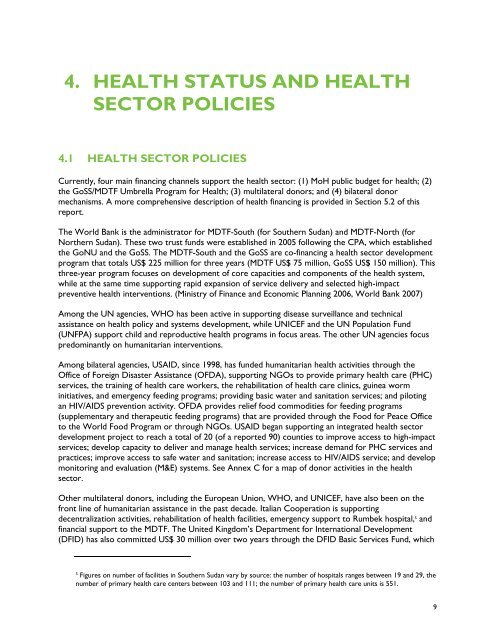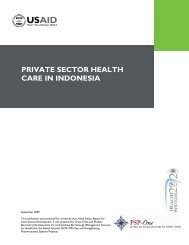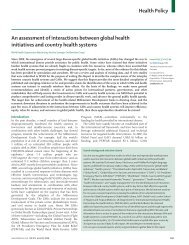southern sudan health system assessment - Health Systems 20/20
southern sudan health system assessment - Health Systems 20/20
southern sudan health system assessment - Health Systems 20/20
Create successful ePaper yourself
Turn your PDF publications into a flip-book with our unique Google optimized e-Paper software.
4. HEALTH STATUS AND HEALTH<br />
SECTOR POLICIES<br />
4.1 HEALTH SECTOR POLICIES<br />
Currently, four main financing channels support the <strong>health</strong> sector: (1) MoH public budget for <strong>health</strong>; (2)<br />
the GoSS/MDTF Umbrella Program for <strong>Health</strong>; (3) multilateral donors; and (4) bilateral donor<br />
mechanisms. A more comprehensive description of <strong>health</strong> financing is provided in Section 5.2 of this<br />
report.<br />
The World Bank is the administrator for MDTF-South (for Southern Sudan) and MDTF-North (for<br />
Northern Sudan). These two trust funds were established in <strong>20</strong>05 following the CPA, which established<br />
the GoNU and the GoSS. The MDTF-South and the GoSS are co-financing a <strong>health</strong> sector development<br />
program that totals US$ 225 million for three years (MDTF US$ 75 million, GoSS US$ 150 million). This<br />
three-year program focuses on development of core capacities and components of the <strong>health</strong> <strong>system</strong>,<br />
while at the same time supporting rapid expansion of service delivery and selected high-impact<br />
preventive <strong>health</strong> interventions. (Ministry of Finance and Economic Planning <strong>20</strong>06, World Bank <strong>20</strong>07)<br />
Among the UN agencies, WHO has been active in supporting disease surveillance and technical<br />
assistance on <strong>health</strong> policy and <strong>system</strong>s development, while UNICEF and the UN Population Fund<br />
(UNFPA) support child and reproductive <strong>health</strong> programs in focus areas. The other UN agencies focus<br />
predominantly on humanitarian interventions.<br />
Among bilateral agencies, USAID, since 1998, has funded humanitarian <strong>health</strong> activities through the<br />
Office of Foreign Disaster Assistance (OFDA), supporting NGOs to provide primary <strong>health</strong> care (PHC)<br />
services, the training of <strong>health</strong> care workers, the rehabilitation of <strong>health</strong> care clinics, guinea worm<br />
initiatives, and emergency feeding programs; providing basic water and sanitation services; and piloting<br />
an HIV/AIDS prevention activity. OFDA provides relief food commodities for feeding programs<br />
(supplementary and therapeutic feeding programs) that are provided through the Food for Peace Office<br />
to the World Food Program or through NGOs. USAID began supporting an integrated <strong>health</strong> sector<br />
development project to reach a total of <strong>20</strong> (of a reported 90) counties to improve access to high-impact<br />
services; develop capacity to deliver and manage <strong>health</strong> services; increase demand for PHC services and<br />
practices; improve access to safe water and sanitation; increase access to HIV/AIDS service; and develop<br />
monitoring and evaluation (M&E) <strong>system</strong>s. See Annex C for a map of donor activities in the <strong>health</strong><br />
sector.<br />
Other multilateral donors, including the European Union, WHO, and UNICEF, have also been on the<br />
front line of humanitarian assistance in the past decade. Italian Cooperation is supporting<br />
decentralization activities, rehabilitation of <strong>health</strong> facilities, emergency support to Rumbek hospital, 5 and<br />
financial support to the MDTF. The United Kingdom’s Department for International Development<br />
(DFID) has also committed US$ 30 million over two years through the DFID Basic Services Fund, which<br />
5<br />
Figures on number of facilities in Southern Sudan vary by source: the number of hospitals ranges between 19 and 29, the<br />
number of primary <strong>health</strong> care centers between 103 and 111; the number of primary <strong>health</strong> care units is 551.<br />
9
















